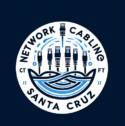What Is the Longest Network Cable? Understanding Distance Limits and Performance
When setting up a wired network, one of the most common questions people ask is, “What is the longest network cable I can use without losing performance?” The answer depends on the type of Ethernet cable you’re using, the speed of your network, and the installation environment.
Let’s break down how long your cables can be before your signal starts to weaken, and what you can do to extend your connection even farther. Our team of structured cabling professionals in Santa Cruz ensures that every installation meets performance standards, even for extended cable runs.
How Ethernet Cable Length Affects Network Performance
All Ethernet cables — whether CAT5e, CAT6, or CAT6a — transmit data using electrical signals. As these signals travel along the copper wires inside the cable, they weaken over distance, which can lead to packet loss, lower speeds, and interference.
To maintain reliable performance, there are industry-standard length limits defined by the TIA/EIA (Telecommunications Industry Association).
Maximum Length for Common Ethernet Cables
Here’s a quick overview of the maximum cable lengths for the most popular Ethernet types:
| Cable Type | Maximum Length | Maximum Speed | Use Case |
|---|---|---|---|
| CAT5e | 100 meters (328 feet) | Up to 1 Gbps | Home networks, small offices |
| CAT6 | 100 meters (328 feet) | 1 Gbps (10 Gbps up to 55m) | Modern business networks |
| CAT6a | 100 meters (328 feet) | Up to 10 Gbps | High-speed enterprise use |
| CAT7 | 100 meters (328 feet) | Up to 10 Gbps | Data centers, shielded environments |
| CAT8 | 30 meters (98 feet) | Up to 40 Gbps | Short-distance, high-bandwidth setups |
In short:
The longest recommended Ethernet cable run is 100 meters (328 feet) for most standard copper cables such as CAT5e, CAT6, and CAT6a. Beyond that, signal loss becomes noticeable unless you use additional hardware to extend the connection.
What Happens If You Exceed 100 Meters?
If you run a cable longer than 100 meters, you’ll likely notice:
- Slower network speeds
- Unstable connections
- Packet loss
- Reduced data transmission quality
This happens because the electrical signals degrade as they travel through the copper conductors. For large spaces or multi-building networks, you’ll need ways to boost or extend the signal.
How to Extend Your Network Beyond 100 Meters
If your setup requires longer cable runs, there are several reliable ways to do it:
- Network Switches or Repeaters
Place a network switch or repeater every 100 meters to re-amplify the signal and maintain performance. - Ethernet Extenders
These devices use special circuitry to push Ethernet signals over longer copper distances, sometimes reaching 500 meters or more. - Fiber Optic Cables
For very long distances, fiber optic cabling is the best option. It uses light instead of electricity to transmit data, allowing runs of hundreds or even thousands of meters with no signal degradation. - Power over Ethernet (PoE) Repeaters
For cameras or access points powered via Ethernet, PoE repeaters can extend both power and data beyond the standard 100-meter limit.
When to Use Fiber Optic Cabling
If you’re designing a large-scale or outdoor network — such as connecting multiple buildings or long corridors — fiber optic cabling is your best choice.
Fiber cables can transmit data over up to 10 kilometers (6.2 miles) for single-mode fiber and up to 550 meters (1,800 feet) for multimode fiber.
Other benefits include:
- Zero electromagnetic interference
- Faster speeds (up to 100 Gbps and beyond)
- Longer lifespan and higher reliability
Many businesses in California and beyond use hybrid systems, combining fiber for long runs and copper (like CAT6) for local connections.
Choosing the Right Cable Length for Your Setup
To ensure your network performs at its best:
- Plan your cable routes carefully before installation
- Keep total runs under 100 meters when using copper
- Use patch panels and keystone jacks to organize connections
- Switch to fiber optic for long-distance or outdoor projects
Professional installers can help design a system that fits your building layout and performance needs while staying within technical limits. The maximum length a cable can handle often depends on its internal components — learn more about the three main parts of a cable and how they impact data transmission.
Key Takeaway
The longest Ethernet cable you can use without losing performance is 100 meters (328 feet) for CAT5e, CAT6, and CAT6a cables. For longer distances, use network switches, Ethernet extenders, or fiber optic cabling to maintain high-speed, reliable connections.
If you’re planning a network installation or upgrade, talk to a structured cabling professional to ensure you get the best balance of speed, distance, and reliability.
